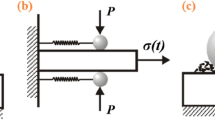Abstract
Surface tracking on organic solid insulators is one of the main reasons for failure in high voltage systems. Due to various factors, such as humidity, pollution, ice load, increase in local voltage, etc., it is hard to estime the lifetime of an insulator. For many years, Weibull statistics have been widely used and accepted as a successful mathematical method of predicting the remaining lifetime of an insulating material. The basic reliability function can perform well for predefined conditions. However, it might be insufficient in lifetime prediction in multi-variable conditions. In this research, a model based on improved Weibull statistics is proposed for estimating the breakdown time of polymeric insulation material. By using appropriate parameters, this improved model can estimate the remaining lifetime within a reasonable accuracy in varying external conditions such as voltages, contaminant flow rates and applied load. To determine the model parameters, several tests are performed according to the IEC 587 accelerated inclined plane tracking test method by investigating the breakdown times of polyesters under various external conditions generated artificially in the laboratory. The calculated results are found to be in good agreement with the experimental data.








Similar content being viewed by others
References
Weibull W(1961) Fatigue testing and analysis of results. Pergamon, Oxford
Wang W, Kececioglu DB (2000) Fitting the Weibull log-linear model to accelerated life-test data. IEEE Trans Reliab 49:217–223
Watkins AJ (1994) Review: likehood method for fitting Weibull log-linear models to accelerated life-test data. IEEE Trans Reliab 49:361–365
Tseng ST, Chyau CH (1994) A classification rule arising from accelerated life tests. Reliab Eng Syst Safety 43:247–256
Newby M (1994) Perspective on Weibull proportional-hazard models. IEEE Trans Reliab 43:217–223
Hagwood C, Clough R, Fields R,(1999) Estimation of the stress-threshold for the Weibull inverse power law. IEEE Trans Reliab 48:176–181
Ugur M, Kuntman A, Merev A (2002) Investigation the ageing process in polymeric insulators using improved Weibull statistics. Paper presented at the International Symposium on Electrical Insulation (2002 ISEI) 7–10 April 2002, Boston, USA
Ardali A, Kuntman A, Kaçar F, Kuntman H (2001) An application of Weibull distribution to hot carrier degradation in threshold voltage and drain current of mos transistors. The 2nd International Conference on Electrical and Electronics Engineering, ELECO'2001, Bursa, Turkey, pp 86–91
Wu EY, Nowak EJ, lersten NRP, Han L-K (2000) Weibull breakdown characteristics and oxide thickness uniformity. IEEE Trans Electron Devices 47:2301–2309
Ross R (1999) Comparing linear regression and maximum likelihood methods to estimate Weibull distributions on limited data sets: systematic and random errors. In: Conference on Electrical Insulation and Dielectric Phenomena, Annual Conference Report, Austin, Tex., pp 170–173
Watson JF, Mason JH, Lynch AC (1979) Assessing materials for use as outdoor insulation. Int Symp High Voltage 3:4
Mason JH (1983) Summary of factors which affect the results of inclined plane tests. CIGRE 1–3
Weller MC (1999) Variation in the results of inclined plane tracking tests: some factors controlling the surface tracking activity. In: Dielectric Materials, Measurements and Applications, Conference on Solid Dielectrics, London, UK, pp 282–286
Billings ML, Wilkings R, Warren L (1968) A comparison of the IEC Dust/Fog and Inclined plane test. IEEE Trans Electr Insul 3:33–39
ASTM (1983) Standard test methods for liquid contaminant, inclined plane tracking and erosion of insulating materials, ASTM (2303), pp 258–270
Cacciari M, Montanari GC (1992) Electrical life threshold models for solid insulating materials subjected to electrical and multiple stresses: probabilistic approach to generalized life models. IEEE Trans Electr Insul 27:987–999
Montanari GC (1992) Electrical life threshold models for solid insulating materials subjected to electrical and multiple stresses: investigation and comparison of life models. IEEE Trans Electr Insul 27:974–986
Auckland DW, Ugur M, Varlow BR(1995) A surface tracking model for failure prediction. In: International Conference on Conduction and Breakdown in Solid Dielectrics (ICSD95), Leicester, UK, pp 503–507
Risino AJ (1994) New test methods for assessing the relative tracking performance of insulating materials. PhD Dissertation, University of Manchester
Houlgate R (1996) Outdoor testing on non ceramic insulators. In: IEE Colloquium on a Review of Outdoor Insulation Materials. IEEE, Piscataway, N.J., pp 8.1–8.4
Crine P, Vijh AK(1985) A molecular approach to the physicochemical factors in the electrical breakdown of polymers. Appl Phys Commun 5:139–163
Wintle HJ (1983) Conduction processes in polymers. In: Bartnikas R, Eichhorn RM (eds) Engineering dielectrics, vol IIA. ASTM Special Technical Publication 763, pp 239–354
Wiesmann HJ, Zeller HR (1986) A fractal model of dielectric breakdown and prebreakdown in solid dielectrics. J Appl Phys 60:1170–1173
Crine P (1992) Applications of the rate theory to the understanding of various dielectric aging mechanisms. Paper presented at the Conference on Electrical Insulation and Dielectric Phenomena, Victoria, Canada
Montanari GC, Simoni L (1993) Aging phenomenology and modeling. IEEE Trans Dielectr Electri lnsul 28:755–776
Stone GC, Heeswijk RGV (1977) Parameter estimation for the Weibull distribution. IEEE Trans Electr Insul 12:253–261
Chatfield C (1991) Statistics for technolgy, 3rd edn. Chapman & Hall, Bristol
Acknowledgements
This work was supported by the Research Fund of the University of Istanbul. Project number 34/03092002.
Author information
Authors and Affiliations
Corresponding author
Rights and permissions
About this article
Cite this article
Ugur, M., Kuntman, A. & Ersoy, A. A study on the ageing process for polyester resin using improved Weibull statistics. Electr Eng 85, 283–288 (2003). https://doi.org/10.1007/s00202-003-0175-5
Received:
Accepted:
Published:
Issue Date:
DOI: https://doi.org/10.1007/s00202-003-0175-5




